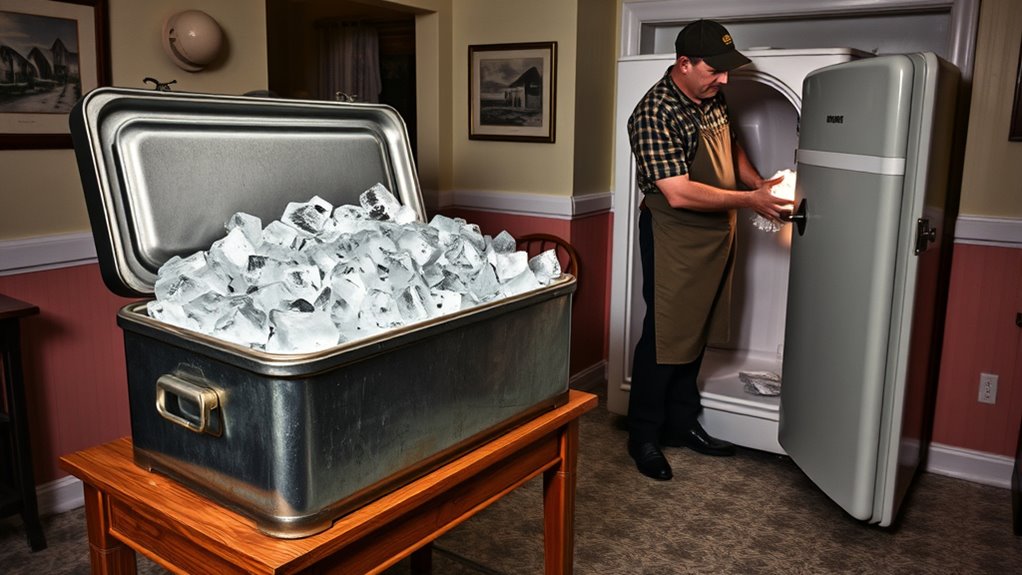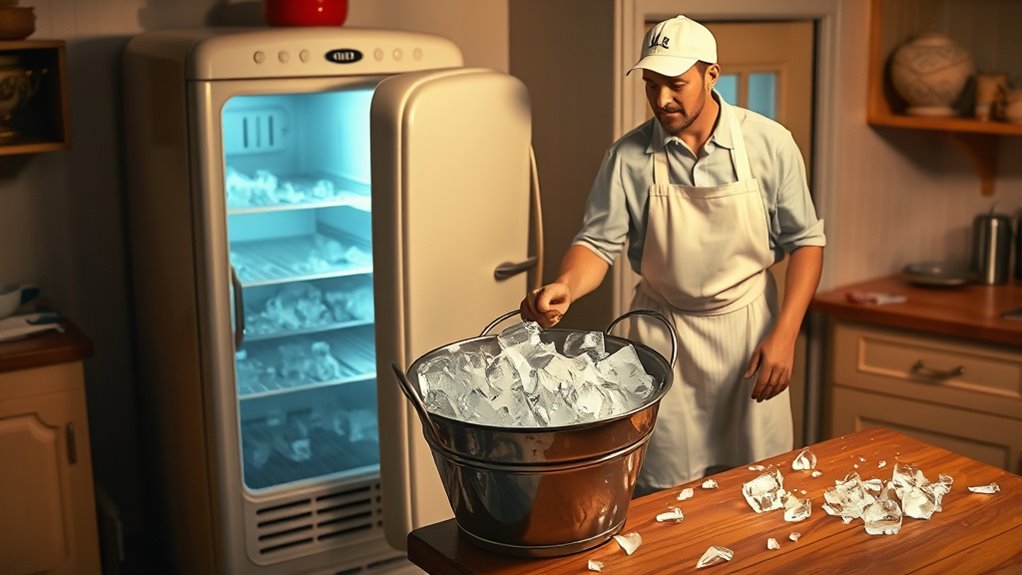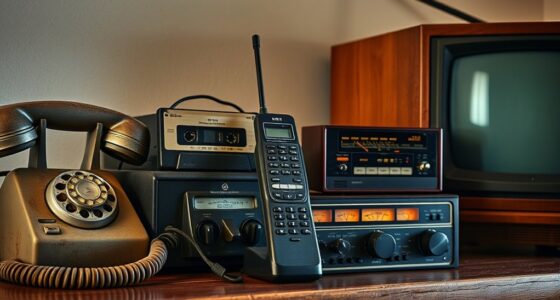Before electric refrigerators became common in the early 20th century, you relied on regular ice deliveries to keep your food fresh. Ice was harvested from lakes in winter, stored in insulated icehouses, and delivered to homes to cool iceboxes. This seasonal system supported food preservation, hospitals, and industries until advances in refrigeration technology made ice delivery obsolete. If you want to discover how this icy practice transformed daily life, keep exploring the story behind refrigeration’s evolution.
Key Takeaways
- Before electric refrigerators, ice delivery was essential for preserving food in iceboxes.
- Ice harvesting from lakes supplied blocks used to keep perishables cold year-round.
- The rise of mechanical refrigeration in the early 20th century reduced the need for ice delivery.
- By mid-20th century, electric refrigerators with built-in freezers made ice delivery largely obsolete.
- Ice delivery was a crucial component of food preservation until modern refrigeration technology replaced it.

Have you ever wondered how refrigerators and ice delivery services have transformed daily life? It’s a fascinating story that begins with ice harvesting and the evolution of refrigeration history. Before modern appliances, keeping food fresh was a daily challenge. People relied heavily on natural ice harvested from lakes and rivers during winter. Ice harvesting involved cutting large blocks of ice from frozen bodies of water and storing them in icehouses lined with straw or sawdust for insulation. This method was essential for preserving perishable goods in warmer months and supported the early ice delivery industry, which supplied homes and businesses with ice year-round.
Ice harvesting from lakes and rivers was essential for food preservation before modern refrigeration.
During the 19th century, ice harvesting became a significant industry. As demand grew, so did innovations in refrigeration technology. The refrigeration history is marked by a series of breakthroughs that gradually replaced ice-based cooling. Early refrigeration systems used compressed gases and mechanical refrigeration units, leading to the development of household refrigerators in the early 20th century. These appliances eliminated the need for ice delivery, providing a more convenient and reliable way to keep food cold. But before these advancements, ice delivery was indispensable. It wasn’t just for preserving food; it also supported ice cream production, hospitals, and even industries like brewing.
When refrigerators needed ice delivery, it meant that the technology to produce ice at home was either unavailable or too costly for many households. Ice delivery companies became a critical part of daily life, especially in urban areas where access to natural ice was limited. They delivered blocks of ice directly to homes, often stored in iceboxes that kept perishables cold. You might have remembered seeing the large wooden or metal boxes with a lid and a compartment for ice. The process was labor-intensive, and delivery schedules depended heavily on the season and the weather.
As refrigeration technology advanced, the reliance on ice delivery declined. Electric refrigerators with built-in freezers rendered the need for external ice obsolete by the mid-20th century. Despite this shift, the impact of ice harvesting and the early refrigeration history is undeniable. They laid the foundation for modern food preservation and climate control systems. Moreover, the development of refrigeration technology played a crucial role in shaping our modern food industry. Today, we take for granted the convenience of just opening our fridges, but understanding this chilling history reveals how far we’ve come and how these innovations revolutionized daily life. So next time you grab a cold drink or store leftovers, remember the icy past that made it all possible.
Frequently Asked Questions
How Did Ice Delivery Influence Early Refrigerator Technology?
Ice delivery played a key role in shaping early refrigerator technology. You see, ice harvesting supplied the ice needed for cooling, allowing people to preserve food longer. This practice drove the refrigeration evolution, as inventors sought alternatives to reliance on ice. Over time, innovations emerged, leading to electric refrigerators that no longer depended on ice delivery. Your understanding of this history highlights how practical needs spurred technological advancements in food preservation.
Were There Regional Differences in Ice Delivery Services?
You’d be amazed at how regional distribution and seasonal variations shaped ice delivery services. In hotter climates, deliveries came more often, almost like clockwork, while colder regions saw fewer trips, sometimes only in summer. These differences meant your access to ice depended on where you lived and the season, making the ice delivery network a fascinating map of local needs and climate patterns that kept everyone cool.
What Safety Precautions Were Taken During Ice Delivery?
You should always follow strict delivery protocols to guarantee ice safety. Delivery personnel typically wore gloves and used sanitized equipment to prevent contamination. They also maintained proper handling techniques to avoid spills and injuries. Clear communication with customers about safe storage practices was essential. These precautions helped protect you from health hazards, ensuring the ice you received was safe to use and that the delivery process was hygienic and efficient.
How Did Refrigeration Impact Ice Harvesting Industries?
You see, refrigeration revolutionized ice harvesting industries by reducing the reliance on natural ice. As refrigeration evolved, it enabled more consistent, year-round ice production, making it easier to store and distribute ice efficiently. This shift diminished demand for traditional ice harvesting, transforming the industry from seasonal work to a steady, industrial operation. Ultimately, refrigeration’s advancement reshaped how ice was produced, stored, and delivered, ensuring a more reliable supply for various needs.
When Did Home Ice Makers Replace the Need for Delivery?
You’ll find that home ice makers began replacing delivery methods in the mid-20th century, around the 1950s and 1960s. As ice harvesting declined, these appliances became popular, making ice readily available without relying on delivery. This shift transformed how people stored and used ice daily, reducing the need for traditional delivery methods and making ice more convenient and accessible right in your own home.
Conclusion
Today, you enjoy the convenience of instant refrigeration at the push of a button, unlike those early days when ice delivery was your lifeline. Back then, you relied on cold trucks and icy blocks to keep your food fresh—an effort that required patience and planning. Now, you take for granted what once was a weekly chore. It’s a stark reminder: progress cools the past’s labor, making life simpler, yet somehow less tangible.









